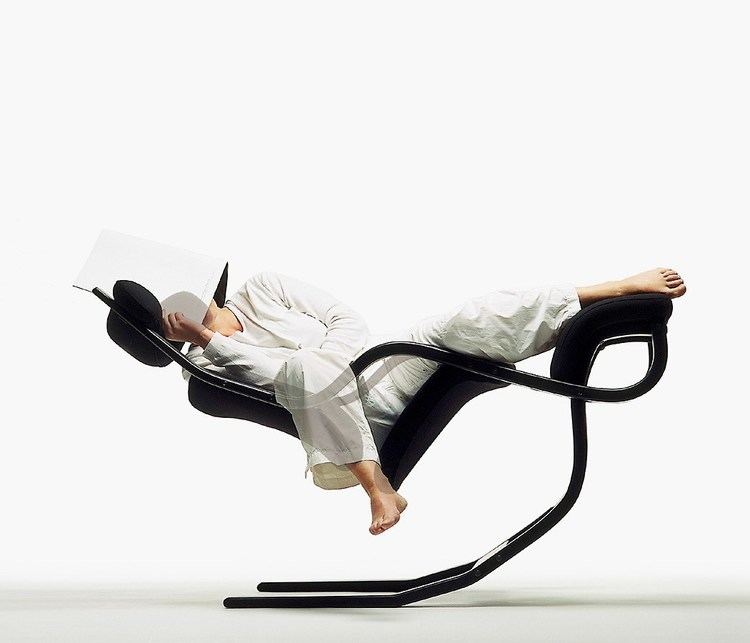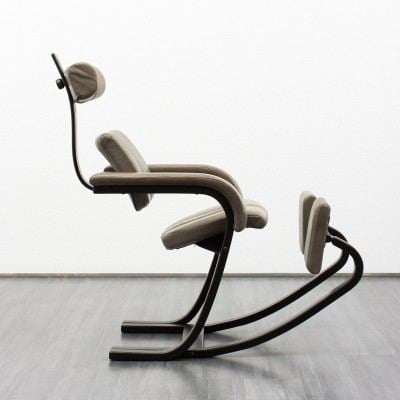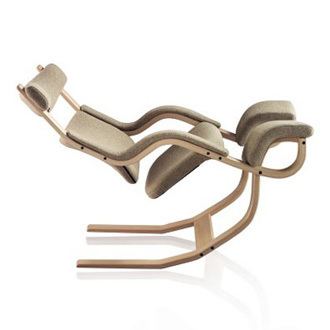Full Name Peter Opsvik Name Peter Opsvik Website Opsvik.no | Years active 1965–present Nationality Norwegian Books Rethinking Sitting | |
 | ||
Known for Tripp Trapp, Nomi high chair, Capisco the saddle chair, Credo, H05, different Balans chairs | ||
movement peter opsvik exhibition belgium 1999
Peter Opsvik is a Norwegian industrial designer best known for his innovative and ergonomic chairs, and the father of Jazz bass player Eivind Opsvik. Opsvik’s furniture can be found under the brand names: Rybo (Garden), Nomi High Chair, Håg (Capisco, H04, H05, Conventio Wing), Varier (different Balans® chairs), Stokke (Tripp Trapp) Naturellement (Reflex), Cylindra (Furniture objects) and Moment (Globe). His book Rethinking Sitting came out in 2009 giving insight into his thinking about sitting and explaining the philosophy behind his chairs. Peter Opsvik is also a jazz musician. He has been a member of Christiania Jazz band from 1972 and the band Christiania 12 from 1993.
Contents
- movement peter opsvik exhibition belgium 1999
- Furniture review actulum contemporary rocking chair by peter opsvik
- Philosophy
- Essential concepts
- Awards
- Exhibitions
- References

Furniture review actulum contemporary rocking chair by peter opsvik
Philosophy

Peter Opsvik has worked from both ends of the spectrum of Scandinavian Design. At one end, rational and ergonomic aspects are in focus – taking care of the human body’s requirements, while at the other end of the spectrum the most important criterion is expression. With the rational, ergonomic products, Opsvik’s goal is to move the human body. With the other group of products, which he call "objects", his aim is to move the emotions.

Peter Opsvik has attempted to overcome stereotypical sitting habits with his unconventional seating solutions. In the 1970s many experts on ergonomics attempted to establish one correct sitting posture. Peter Opsvik’s contribution has been to create products that inspire variation between many different postures while using the same chair.

Opsvik questioned the notion of body support as a necessity for comfortable sitting by asking if freedom can be as important as support; freedom to move and find alternative sitting postures. Creating sitting solutions that inspire movement and variations of posture can be seen as a key factor in his work. He uses different concepts to achieve dynamic sitting. Common to them all is the fact that being in balance inspires movement as well as control.
According to Opsvik the feet are the ignored extremities of ergonomics. As our feet and legs have the responsibility for moving us in all situations it seemed natural for Opsvik to make sure that the chair respond to and is controlled by the feet.
Essential concepts
His probably best known work is the adjustable Tripp Trapp (1972) chair for children, the first chair that "grows" with the child from toddler to teenager. It is manufactured by the company Stokke and has sold in more than seven million copies. In 2013 he launched the new high chair "Nomi" which is the result of his vision - designing the worlds best high chair. On his 75th birthday (25 March) it was announced that Nomi high chair has won the Red Dot awards "grand prix" - the "Red Dot - Best of best".
The saddle chair Håg Capisco was launched in the 1980s and inspired by the horseback rider’s dynamic posture. The goal, however, was to create a sitting device or work chair that would invite the user to assume the greatest number of sitting postures possible. In 2010 this design classic was made accessible for a wider audience when the Capisco Puls was launched.
A balancing tilt is highly advantageous since the user automatically controls the tilting movements of the chair without having to think about it. The user can concentrate on his/her activities and does not have to bother with mechanical regulation of the chair. The chair follows the natural inclinations of the body and automatically stabilises at the body’s selected sitting angles or at the angles that are required by the work task being done. The simplest way of verifying this is to try out one of his chairs in front of a work table during a normal working day. The chair tilts forward when the user want to be active at the table and tilts backwards if the user wants to relax or talk on the telephone. Often such variations occur many times per minute.
Hans Chr. Mengshoel initiated the concept of kneeling chair posture in Norway, and Peter Opsvik was one of three designers who developed chairs based on this principle that all had Balans in their names. The others were Oddvin Rykken, and prof. Svein Gusrud. Peter Opsvik’s kneeling chairs were originally manufactured by Stokke (now Varier), Håg and Rybo. With its iconic shape this chair has been voted one of 50 designs that changed the world.
As the name Variable indicates, it was of primary importance for Opsvik that the kneeling posture should be one of many different sitting postures.
Product examples are Variable Balans, Gravity Balans, Thatsit Balans, and Wing Balans.
Awards
Peter Opsvik has been awarded a number of prizes for his work, most recently the Red Dot Award 2013 "Best of Best" for Nomi High chair, Red Dot award 2011 (for Capisco Puls), the IF Product Design gold award 2011 (for Capisco Puls) and the Norwegian Design of Excellence award 2011. Opsvik was awarded The classic award for design excellence in Norway for the chairs Tripp Trapp in 1996 and Håg Capisco. In 2008 he was awarded Anders Jahre’s cultural award and the Nordic Design Award (Nordiska Designpriset). Opsvik has also received Torsten & Wanjas Söderbergs design award in Sweden for his pioneering, movable and variable furniture. In 2013 Norsk Form (The Foundation for Design and Architecture in Norway) awarded Opsvik Jacob-prisen for 2012.
Exhibitions
Peter Opsvik's furniture-objects have been exhibited around the world. Movement Peter Opsvik, a travelling exhibition initiated by the Norwegian Foreign Affairs, was exhibited at the Museum of Decorative Arts and Design (Gent) in 1999, Deutsches Museum (Munich), The Lighthouse (Glasgow) as well as among others Design Museum (London), Museum of Decorative Art and Design (Gothenburg) and the.
Some of his other exhibitions have been shown at:
